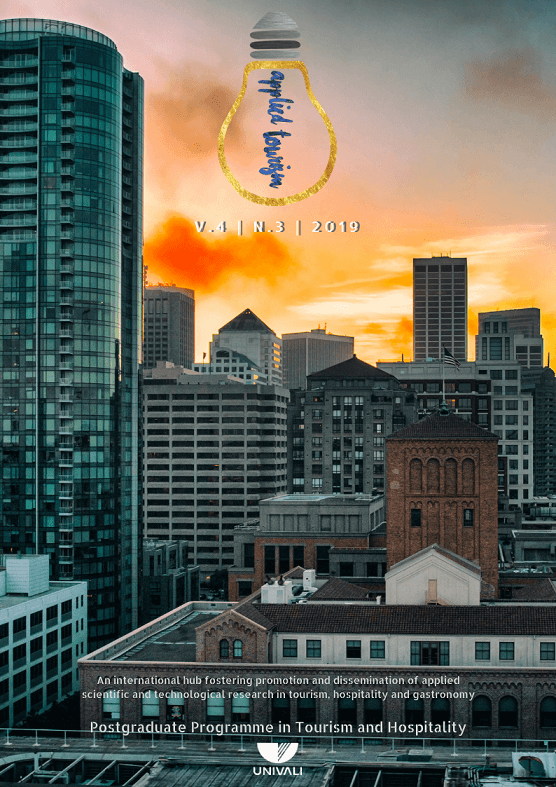International tourism spatial distribution: an alternative cartography of World Tourism Organization (Unwto) Data
DOI:
https://doi.org/10.14210/at.v4n3.p47-54Palavras-chave:
Spatial distribution of tourism. International tourism. UNWTO.Resumo
The UNWTO is responsible for collecting and disseminating International Tourism data about 200 states among its associate members and affiliates. Traditionally this information is disclosed in the Compendium of Tourism Statistics, whose access is restricted or paid. The WTO reports also present the data aggregated in accord to the regional division of the world established by the UNWTO itself. This work aims to present an alternative cartography and to discuss the spatial distribution of international tourism. This was done from the UNWTO database, available by the World Bank. The interval between 2006 and 2016 was chosen for analysis. The indicators presented are: the average of international arrivals from 2006 to 2016; the variation in the number of international arrivals between 2006 and 2016; the ratio between international arrivals and each country's population in 2016; the ratio between international tourism revenue and international arrivals between over 2006 and 2016; the variation in international tourism revenues between 2006 and 2016; the variation in international tourism spending between 2006 and 2016. The discussion of these indicators is important for a deeper understanding of the dynamics of international tourism, which goes far beyond the traditional debate around the often-released top ten rankings.
Referências
CAZES, G. (1992). Tourisme et Tiers-Monde: un bilan controversé. Paris: Harmattan,
FIDH. Saffron Revolution, (2007). Available at: <https://www.fidh.org/IMG/pdf/BIRMÂNIA-DEC2007.pdf> on 01/10/2019.
LENOIR, N. & LAPLACE, I. (2016). Liberalization in Southeast Asia: who is capturing the markets? WCTR 2016, World Conference on Transport Research, Shanghai, China.
NAÇÕES UNIDAS. Población, total. Available at: https://datos.bancomundial.org/indicador/SP.POP.TOTL On 30 abr. 2019.
NETTO, A. & TRIGO, L. (2016) (Org.). Turismo na América Latina: Casos de sucesso. Assis: Triunfal Gráfica e Editora, 366 p. Available at: . On Oct 2019.
PIERI, V.S.G. (2014). Fluxos Turísticos Internacionais: uma proposta metodológica de análise sobre os (novos) destinos. Turismo em Análise, n. 25, v.3. Available at: http://www.revistas.usp.br/rta/article/download/87678/pdf_14/ On Apr 2019.
PIMENTEL, M.R. (2017). Uma abordagem geográfica do Turismo: visitando Porto Alegre. Tese (Doutorado em Geografia) – Instituto de Geociências, Universidade Federal do Rio Grande do Sul, Porto Alegre. Available at: https://www.lume.ufrgs.br/handle/10183/170539 On Apr 2019.
SILVEIRA, M.A (2014). Geografia aplicada ao turismo: Fundamentos teóricos-práticos. Curitiba: Intersaberes. 327 p.
UNWTO (2019). Panorama OMT del Turismo Internacional. Edición 2018. Madri:. Available at: https://www.e-unwto.org/doi/pdf/10.18111/9789284419890 On Apr 2019.
UNWTO (2010). Recomendaciones Internacionales para Estadísticas de Turismo 2008. Madri / Nova Iorque. Available at: https://unstats.un.org/unsd/publication/Seriesm/SeriesM_83rev1s.pdf on Apr 2019.
UNWTO. Turismo Internacional, gastos (US$ a precios actuales). Available at: https://datos.bancomundial.org/indicador/ST.I NT.XPND.CD?view=chart On 30 Apr 2019a.
UNWTO. Turismo Internacional, número de Arribos. Available at: https://datos.bancomundial.org/indicador/ST.INT.ARVL?view=chart On Apr 2019b.
UNWTO. Turismo Internacional, recibos (US$ a precios actuales). Available at: https://datos.bancomundial.org/indicador/ST.INT.RCPT.CD?view=chart On Apr 2019c.
Downloads
Publicado
Edição
Seção
Licença
Neste termo de responsabilidade certifico(amos) que participei(amos) da elaboração do artigo anexo, desta forma tornando pública a minha(nossa) responsabilidade pelo seu conteúdo. Declaro(amos) que não omitimos quaisquer ligações ou acordos de financiamento entre eu (nós) e entidades e / ou instituições que possam ter interesse na publicação deste artigo. Certifico(amos) que o artigo é original e que o trabalho, no todo ou em parte, ou qualquer outro trabalho com conteúdo substancialmente similar, de minha (nossa) autoria, não foi enviado a outro periódico e não o serão enquanto sua publicação estiver sendo considerada pela Applied Tourism, em qualquer formato (impresso ou eletrônico). Neste termo de consentimento, os autores relacionados dão permissão à Applied Tourism, no caso de aprovação pelo Conselho Editorial dessa, para a publicação do artigo anexo em cópia impressa e/ou eletrônica em edição regular da revista, e para o envio a base de dados.
Você tem o direito de:
- Compartilhar — copiar e redistribuir o material em qualquer suporte ou formato
- Adaptar — remixar, transformar, e criar a partir do material
- para qualquer fim, mesmo que comercial.
- O licenciante não pode revogar estes direitos desde que você respeite os termos da licença.
De acordo com os termos seguintes:
Atribuição — Você deve atribuir o devido crédito, fornecer um link para a licença, e indicar se foram feitas alterações. Você pode fazê-lo de qualquer forma razoável, mas não de uma forma que sugira que o licenciante o apoia ou aprova o seu uso.
CompartilhaIgual — Se você remixar, transformar, ou criar a partir do material, tem de distribuir as suas contribuições ao abrigo da mesma licença que o original.
- Sem restrições adicionais — Você não pode aplicar termos jurídicos ou medidas de caráter tecnológico que restrinjam legalmente outros de fazerem algo que a licença permita.










